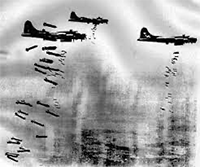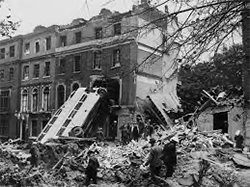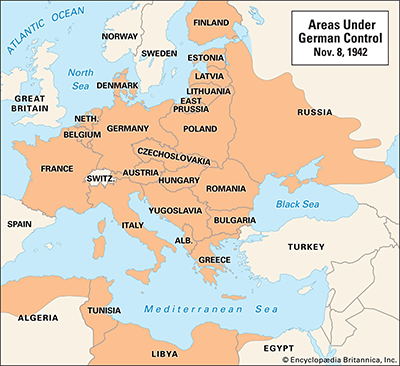Germany and the United Kingdom had a number of agreements still on the books. One by one, Germany violated the terms of those agreements. One particularly (to Germany) vexing recent U.K. foreign policy pronouncement was that it was in full support of the independence of Poland and would act to protect any violation of that independence. France, too, was in agreement on that point. Hitler was aware that his rearmament program was progressing, but he didn't want a war with France and the U.K. just yet. Germany's foreign minister at the time, Joachim von Ribbentrop, had been the country's ambassador to London and was firmly convinced that an invasion of Poland would be met with noninterference from both France and the U.K. Hitler, wanting to take over Poland next, agreed and then, protecting against a two-front war, secured an agreement with the Soviet Union that not only guaranteed noninterference from Poland's large eastern neighbor but guaranteed the Soviet leader Joseph Stalin a piece of Poland real estate. The Molotov-Ribbentrop Pact, also known as the "Pact of Steel," came about on August 23. Two days later, the U.K. reaffirmed its support for Polish independence. Seizing the moment, Hitler ordered an invasion, and German troops entered Poland in waves on September 1, 1939. World War II had begun. 
Two days later, with Poland in ruins, France and the U.K. declared war on Germany. Those declarations did not immediately result in troop mobilizations, and a Soviet army occupied the eastern part of Poland on September 17. Poland was occupied, violently so. The German blitzkrieg overwhelmed all before it. After a winter largely devoid of military activity, Hitler ordered more invasions. German troops marched into Denmark and Norway on April 9, 1940, and then in May into Belgium, France, Luxembourg, and the Netherlands. The German victory over France was particularly swift, and the two countries signed an armistice on June 22. Hitler, still smarting from the German defeat in World War I, insisted that the agreement be signed in the same rail car in which the two countries had signed the armistice that ended World War I, in 1918. Powering the German Wehrmacht was the powerful Luftwaffe, the most technologically advanced air force in the world. Bombers and fighter planes featured heavily in the war strategy. Also in violation of the Treaty of Versailles, German pilots had also endured years of intensive training. The same was true of the Heer, army, sporting advanced weaponry and years of drilling and preparing for war. Estimates are that of the 18 million soldiers who served in the German Armed Forces during World War II, more than 13 of them werved in the Army. The U.K. had a large contingent of troops and other personnel in France, as the German forces rolled up more and more of the French lands and by May 24 had reached the Atlantic Coast and were ready to seize Dunkirk, home to large numbers of the British Expeditionary Force and other allied troops. A sudden halt to let German planes rain down bombs on the Allied forces huddled in Dunkirk led to a large-scale deployment of a ragtag rescue fleet. Fishing boats, pleasure yachts, and even lifeboats arrived by the hundreds, providing an escape where none had seemed possible. Hundreds of thousands of soldiers escaped Dunkirk. 
Hitler tried to convince the new U.K. prime minister, Winston Churchill, to sign an armistice. Churchill refused, and the German response was to bomb London, most nights, for a period of weeks. The intended targets were U.K. airbases and radio stations. German bombs also targeted U.K. ports and convoys and were so successful that the U.K. military ended daytime shipping in the area. A target as well was the civilian populace, specifically their will to keep up the fight. With Churchill leading the way, the U.K. did not give up the fight. Hitler had dreamed of invading and occupying the U.K., but he ended any plans for such an invasion on September 1. The aerial bombings continued for another few weeks but then stopped. During that fierce fighting over the skies of London and surrounds, German troops were solidifying their positions in France and elsewhere in Europe. Italian leader Mussolini had joined the fray and launched his own attacks. Coming onboard as well in September 1940 was Japan, signing the Tripartite Pact. Germany invaded North Africa in early 1941; as well, German forces arrived in the Balkans and the Middle East, supporting Italian military actions there and also acting for their own interests. German forces in April 1941 invaded Yugoslavia and then Greece and then Crete. All this time, the Soviet Union had stood by its agreement to occupy eastern Poland and then not interfere with German aggression in the west. Hitler tried strenuously to get Stalin to join him in the war against the U.K.; Stalin refused. Hitler, who had long wanted to invade the Soviet Union and who had recruited many of the vaunted Wehrmacht with secret promises to fight communism, ordered a large-scale invasion of Soviet territory in the summer of 1941. On June 22, Operation Barbarossa began, with thousands of soldiers, planes, and tanks storming their way deep into the western part of the U.S.S.R. Quick to fall were Belarus and West Ukraine. (A byproduct of this invasion was German occupation of the Baltic republics of Estonia, Latvia, and Lithuania, which like Czechoslovakia were relatively new countries, having found their independence after the end of the Russian Empire in the waning days of World War I.) 
German forces had advanced more than 300 miles in two short months and were within 250 miles of the Soviet capital, Moscow, when Hitler ordered the vaunted Panzer tank groups to move away; the idea was that they would help with the occupation of two other large cities, Kiev and Leningrad. This diversion of forces helped the Soviet forces to regroup and fortify; when the German advance on Moscow resumed, in October, the Russian winter was fast approaching. The German attack bogged down in the snow and ice and, in January 1942, failed to take Moscow. As a result of this, Hitler dismissed his supreme army commander, Field Marshal Walther von Brauchitsch; in his place, Hitler named himself. Next page > Final Solution, Final Descent > Page 1, 2, 3, 4, 5, 6 |
|
Social Studies for Kids
copyright 2002–2025
David White




